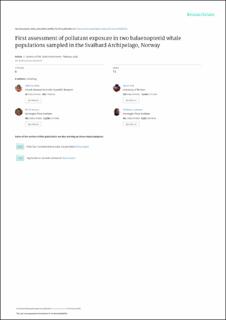| dc.contributor.author | Tartu, Sabrina | |
| dc.contributor.author | Fisk, Aaron | |
| dc.contributor.author | Götsch, Arntraut | |
| dc.contributor.author | Kovacs, Kit M. | |
| dc.contributor.author | Lydersen, Christian | |
| dc.contributor.author | Routti, Heli | |
| dc.coverage.spatial | Svalbard | en_US |
| dc.date.accessioned | 2020-02-27T09:45:51Z | |
| dc.date.available | 2020-02-27T09:45:51Z | |
| dc.date.issued | 2020-02 | |
| dc.identifier.issn | 1879-1026 | |
| dc.identifier.uri | https://hdl.handle.net/11250/2644118 | |
| dc.description.abstract | Pollutant concentrations are poorly known for the largest animals on Earth, blue whales Balaenoptera musculus and fin whales Balaenoptera physalus. In this study, concentrations of persistent organic pollutants (POPs) were determined in blubber biopsies and stable isotope values for nitrogen (δ15N) and carbon (δ13C) were measured using skin biopsies for 18 blue whales and 12 fin whales sampled in waters surrounding the Svalbard Archipelago, Norway. The samples were collected in summer during the period 2014-2018. POPs were dominated by DDTs, PCBs and toxaphenes, with median concentrations in blue/fin whales being 208/341, 127/275 and 133/233 ng/g lipid weight, respectively. Linear models indicated that pollutant concentrations were 1.6-3 times higher in fin whales than in blue whales, which is likely related to the higher trophic positions of fin whales, as indicated by their higher δ15N. Lower δ13C in fin whales suggests that they feed at higher latitudes than blue whales; these values were not correlated with pollutant concentrations. Pollutant levels were approximately twice as high in males compared to females (intraspecifically), which indicates that females of these species offload pollutants to their offspring during gestation and lactation, similar to many other mammalian species. Pollutant concentrations in balaenopterid whales from Svalbard waters were generally much lower than in conspecific whales from the Mediterranean Sea or the Gulf of California, but higher than those in conspecifics from the Antarctic Peninsula. | en_US |
| dc.language.iso | eng | en_US |
| dc.publisher | Elsevier | en_US |
| dc.rights | Navngivelse 4.0 Internasjonal | * |
| dc.rights.uri | http://creativecommons.org/licenses/by/4.0/deed.no | * |
| dc.subject | svalbard | en_US |
| dc.subject | blue whale | en_US |
| dc.subject | fin whale | en_US |
| dc.subject | contaminants | en_US |
| dc.subject | stable isotopes | en_US |
| dc.title | First assessment of pollutant exposure in two balaenopterid whale populations sampled in the Svalbard Archipelago, Norway | en_US |
| dc.type | Peer reviewed | en_US |
| dc.type | Journal article | |
| dc.description.version | publishedVersion | en_US |
| dc.source.pagenumber | 1-11 | en_US |
| dc.source.volume | 718 | en_US |
| dc.source.journal | Science of the total environment | en_US |
| dc.identifier.doi | 10.1016/j.scitotenv.2020.137327 | |
| dc.relation.project | Norges forskningsråd (ICE whales): 121325 - Giants of the ocean – affected by anthropogenic pollutants? | en_US |

